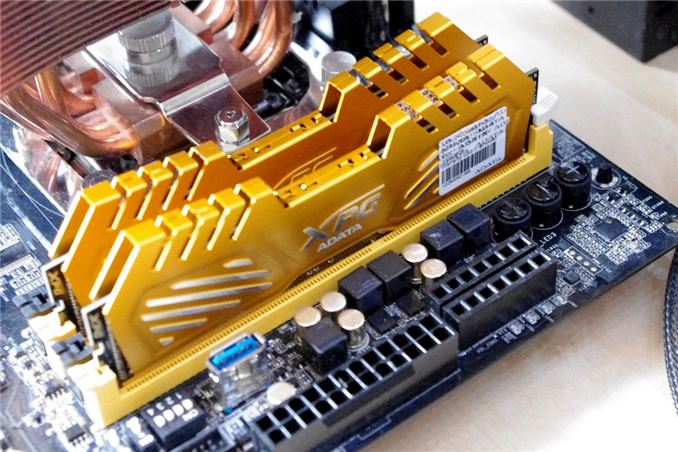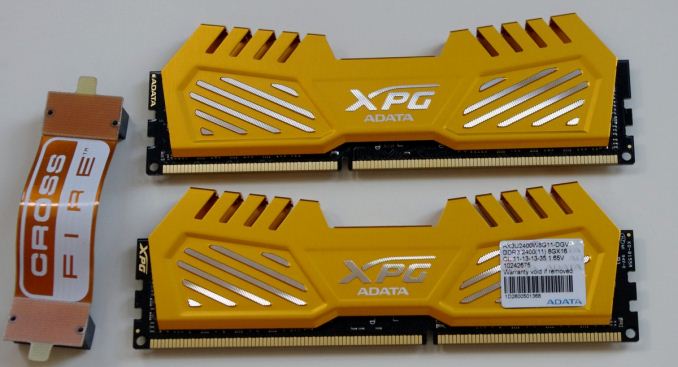ADATA XPG V2 Review: 2x8 GB at DDR3-2400 C11-13-13 1.65 V
by Ian Cutress on November 11, 2013 1:00 PM EST
Memory has an odd part to play in the desktop ecosystem. There is plenty of it from many different manufacturers at various prices, speeds and benefits. Most of the differentiation comes around the product, such that two sets of 8GB DDR3-1600 might differ in warranty and aesthetics alone. With that in mind, we have several memory kits in the office tested, and the first one under analysis is a 2x8 GB DDR3-2400 C11 kit from ADATA’s XPG V2 line.
ADATA XPG V2 2x8GB DDR3-2400 C11 Overview
ADATA’s XPG (Extreme Performance Gear) V2 line is designed to showcase ADATA’s highest memory speed modules, although the range starts at 1600 C9 and extends to 3100 C12, with all speeds in 2x4 GB kits and 2x8 GB up to DDR3-2800. Each memory kit can be found in gold, as the kit today is, or in a tungsten grey. ADATA sent us several XPG V2 memory kits, such as this 2400 kit and a pair of 2800 kits to review.
The 2x8 2400 C11 kit sits in that spot around the sweet spot for memory tests: it escapes the basic failures that slow kits have, yet the specification precludes the price from spiraling out of control in terms of the memory MHz race that many manufacturers are keen to be a part of. While it is debatable if memory requires heatsinks, the gold colored ones on our XPG V2 aesthetically fit well with our ASRock Z87 OC Formula test bed and any similarly colored motherboard.
Overclocking performance at a boosted 1.72 volts gave a nice jump to 2666 11-13-13 stable, and a performance index of ~240 was applicable up to 2666 MHz from an original kit PI of 218. Out of the kits we have in to test, this was actually one of the better results by comparison.
The AX3U2400W8G11-DGV 2x8 GB kit currently retails at $200, or $12.50/GB. There are obviously cheaper kits available if you just need a 2x8GB kit without concern for the memory speed, but unfortunately for ADATA there are kits available at almost one third less, including their own tungsten grey versions at $140, which offers all the benefits just in a different color. As memory has a tendency to go up and down in pricing, it is often best to check on the day.
Specifications
Memory Specifications
| ADATA | ADATA | Corsair | Patriot | ADATA | G.Skill | |
| Name | - | AX3U2400W8G11-DGV | - | - | - | F3-3000C12D-8GTXDG |
| Speed | 1600 | 2400 | 2400 | 2400 | 2800 | 3000 |
| ST | 9-11-9-27 | 11-13-13-35 | 10-12-12-31 | 10-12-12-31 | 12-14-14-36 | 12-14-14-35 |
| Price | - | $200 | - | $92 | $316 | $520 |
| XMP | - | Yes | Yes | Yes | Yes | Yes |
| Size | 2 x 8GB | 2 x 8GB | 2 x 8GB | 2 x 4GB | 2 x 8GB | 2 x 4GB |
|
Performance Index |
178 | 218 | 240 | 240 | 233 | 250 |
|
|
||||||
| MHz | 1600 | 2400 | 2400 | 2400 | 2800 | 3000 |
| Voltage | 1.35 V | 1.65 V | 1.65 V | 1.65 V | 1.65 V | 1.65 V |
| tCL | 9 | 11 | 10 | 10 | 12 | 12 |
| tRD | 11 | 13 | 12 | 12 | 14 | 14 |
| tRP | 9 | 13 | 12 | 12 | 14 | 14 |
| tRAS | 27 | 35 | 31 | 31 | 36 | 31 |
| tRC | 46 | 49 | ||||
| tWR | 20 | 16 | ||||
| tRRD | 315 | 391 | ||||
| tRFC | 6 | 7 | ||||
| tWTR | 10 | 12 | ||||
| tRTP | 10 | 12 | ||||
| tFAW | 33 | 29 | ||||
| CR | 2 | 2 | ||||
As this is our first proper memory review on Haswell, we have tested some other kits which are going to be the focus of future reviews, and thus as comparison points we have listed them here to give a scale of comparison. Compared to the G.Skill DDR3-3000 12-14-14 kit that was the focus of the Haswell memory overview, the ADATA kit we are testing today seems to have looser tWR and tFAW timings.
Visual Inspection
Thankfully ADATA have avoided using annoying plastic packaging that can be a pain to get into – there is a simple tab on the back to help open their XPG V2 line of memory. The packaging is simple enough, just a thin molded plastic to hold the memory in place:
The modules themselves have additional z-height, measured at 13.8mm for a total height of 44mm (1.73 inches).





















23 Comments
View All Comments
The Von Matrices - Monday, November 11, 2013 - link
The silly part is that this is marketed as "gaming" memory while its advantages in gaming on a discrete GPU are minimal. It should be marketed as accelerating applications, which would be a much more reasonable statement. I bought 2400MHz memory not because I play games but because I perform encoding and file compression on my PC, and that is a situation where fast memory makes a difference.As far as making a recommendation on value, Ian stated (and I agree) that memory prices are very volatile. It's basically impossible to make a lasting value comparison on memory because of this. What is a great deal today could be eclipsed next week by a dramatic price decrease of a faster, better product. I agree with Ian omitting a value comparison because it would be pointless a month after the article is posted. However, the performance comparisons of different memory speeds and timings are still of value.
I think the general conclusion he stated is still of value - buy something faster than DDR3-1600 but don't spend too much money because the performance increase is minimal beyond that.
DanNeely - Monday, November 11, 2013 - link
Are any of your planned reviews going to look at the impact of timing relaxation needed to run 4 dimms instead of 2? Having bumped off 12GB a few times I'm now running 18 in my aging i7-920 box; and with both my browsers (Opera, FF) having multi-process upgrades forthcoming that will let them expand beyond the 4GB barrier I've decided on 4x8gb for my new system.The Von Matrices - Monday, November 11, 2013 - link
I don't understand why you're creating a new term "performance index" instead of just using the more standard time to first word (in ns). It would behave exactly in reverse to your "performance index" with lower times being better but otherwise the comparison would be the same.ShieTar - Tuesday, November 12, 2013 - link
I agree. Its not only more standard, it is also physically more meaningful, and can be adapted to describe the performance of software with known algorithms E.g. if your ramdisk is reading 512-Byte-sectors from memory, its performance will scale with the "time to get a full sector".But of course, frequency is also a much more useful parameter to distinguish electromagnetic signal than wavelength, and you still can't get anybody who learned their field on wavelength to give it up. Once people start to think within certain terms, they are very stubborn about changing definitions.
whyso - Monday, November 11, 2013 - link
If you run IGP benchmarks can you please run at something relevant? 11 fps is not relevant.cmdrdredd - Monday, November 11, 2013 - link
Still with these big heatsinks on the memory? I almost have to use the low profile Samsung stuff because of my Noctua cooler not allowing much clearance.meacupla - Monday, November 11, 2013 - link
I think these unnecessarily tall RAM heatsinks are still being made, because the manufacturers think people will use CLC CPU coolers instead of a dual tower heatsink.or maybe they think the only people who will buy this type of RAM are people with real water cooling loops.
or maybe they are for LNG overclocking contests or something.
Either way, if the customer is sensible enough to buy a tower heatsink in the first place, I'm sure they would also be sensible and buy some lower profile, 1600Mhz or 1866Mhz CAS8 or CAS9 RAM, instead of overkill 2400Mhz.
DanNeely - Tuesday, November 12, 2013 - link
giant ramsinks long predate CLCs. For that matter I'm fairly sure they predate tower style heatsinks as well.Hood6558 - Wednesday, November 13, 2013 - link
Overkill is best, sensible decisions are for Grandma's email machine...Kamus - Tuesday, November 12, 2013 - link
Some battlefield 4 tests would've been nice... According to corsair, 2400 memory was giving up to 20% better performance than 1333.mbut I've yet to see another test like that one to corroborate.